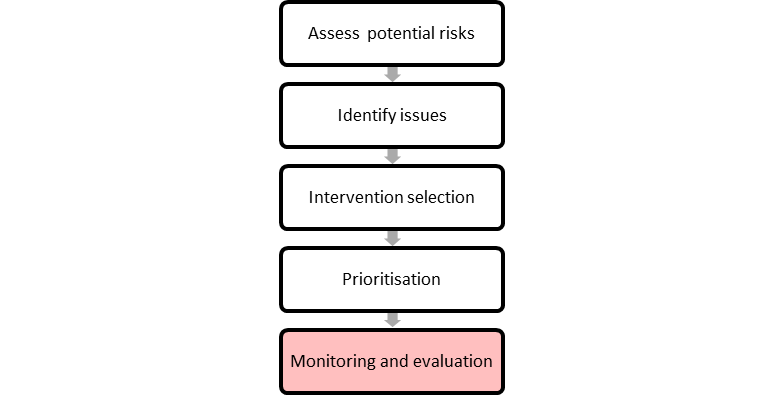
Road Safety Manual
A manual for practitioners and decision makers
on implementing safe system infrastructure!

Road Safety Manual
A manual for practitioners and decision makers
on implementing safe system infrastructure!
The final step of the risk assessment process is the monitoring, analysis and evaluation of interventions (Figure 12.1)

As described in The Road Safety Management System, monitoring, analysis and evaluation is the ‘systematic and ongoing measurement of road safety outputs and outcomes (intermediate and final), and the evaluation of interventions to achieve the desired focus on results’ (GRSF, 2009). These tasks are often overlooked, but are essential for the effective management of road safety.
Earlier chapters have provided information on the role of monitoring, analysis and evaluation in road safety management, including its importance as part of road safety targets and programmes (The Road Safety Management System, and to a lesser extent, Road Safety Targets, Investment Strategies Plans and Projects and Design for Road User Characteristics and Compliance); and the role it plays in data requirements (Identifying Data Requirements). This chapter concentrates on the evaluation process at the network and project level, and includes information on the importance of this process as well as how to undertake monitoring and evaluation.
Monitoring refers to the systematic collection of data regarding the performance of a road safety programme or intervention during or after its implementation. Analysis involves the study of data in order to interpret it and its parts, such as determining the contributing factors to crashes. Evaluation involves the analysis of this data to determine the effect of the treatment or programme.
The purpose of the monitoring and evaluation process is to:
A successful evaluation process requires careful planning, which includes collecting baseline data, identifying the aims before implementation, and considering the different methods of analysis that could be used for the evaluation. It is also essential that the results and feedback of the evaluation study are properly circulated amongst stakeholders and other interested agencies.
There are three main types of evaluation. One or more may be appropriate for a study, and this is dependent on the aims of what needs to be evaluated. The three main types of evaluation are:
Both qualitative and quantitative methods can be used for an evaluation study. Qualitative questions are more useful in process and outcome evaluations in the form of focus groups, or open-answer questionnaires, and can be insightful as to why an intervention may not have been successful. Quantitative studies produce more rigorous outputs through the use of controlled trials or before-and-after studies.
As identified in Priority Ranking Methods and Economic Assessment, information on intervention effectiveness is also important in assessing the likely benefits of safety improvements. The evaluation process is important for improving knowledge regarding the effectiveness of different road safety interventions in different types of environments. The use of such information in the selection and prioritisation of interventions is discussed in Intervention Selection And Prioritisation, while this chapter concentrates on methods for monitoring and evaluation. However, agencies must be cautious about generalising the results of an evaluation.
Processes should be established for the collection of relevant data. For those just getting started, this collection could be undertaken as part of a corridor or area demonstration project.
Staff and financial resources need to be provided for monitoring, analysis and evaluation, and key road agency staff and stakeholders should be trained in basic analysis and evaluation methods. Consideration should be given to the storage and maintenance of the data over time.